View from the US: New York Times journalist Dan Barry on the multi-million dollar fight where nothing was on the line.
The world finally had the two of them contained Saturday night, in a roped-off ring where they had to remain silent and just get on with it. Two mouthy welterweights, neither the best role model for his respective legion of young fans, throwing mocking looks and punches in a spectacle of the inevitable.
Conor McGregor, a 29-year-old Dubliner more famous in some circles than James Joyce, entered the ring first; he is a mixed martial arts champion who was undefeated in professional boxing because he had never fought a round. Following soon after was 40-year old Floyd Mayweather Jr, easily the best fighter of his generation; he, too, was undefeated, at 49-0.
So, then: Do the math.
This wildly lucrative contrivance posing as a boxing match for the ages ended as expected. With clinical detachment, Mayweather pounded McGregor’s punch-reddened face until the referee granted mercy in the 10th round, declaring a technical knockout and perhaps sparing some measure of the Irishman’s future cognitive abilities.
“I thought it was close,” said McGregor immediately after the fight, to the concurrence of no one.
Mayweather, looking as though he had just returned from a light jog, summed things up with a charitable: “I think we gave the fans what they wanted to see.”
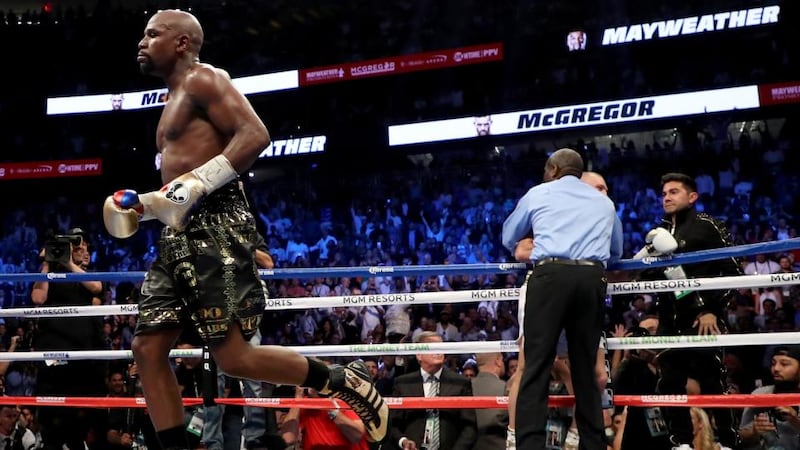
Perhaps. Some wanted Mayweather to win, some wanted McGregor to overcome impossible odds — and some hoped that the two would manage to knock each other out. Mayweather has another record, a criminal one for hitting women, while McGregor has demonstrated a capacity for low verbal blows touching on race, misogyny, Mayweather’s struggle with reading, you name it.
They staged their performance before 14,623 fans at the T-Mobile Arena, many of the men in sharp suits and no socks, many of the women in cocktail dresses and heels, as if attired for a garish wake. There were A-list celebrities, D-list celebrities, people who consider themselves celebrities, swarms of Irish people wrapped in their country’s tricolors, and a posse of young women wearing shirts emblazoned with the name of a company whose website requires that you confirm you’re an adult. Also, some boxing fans.
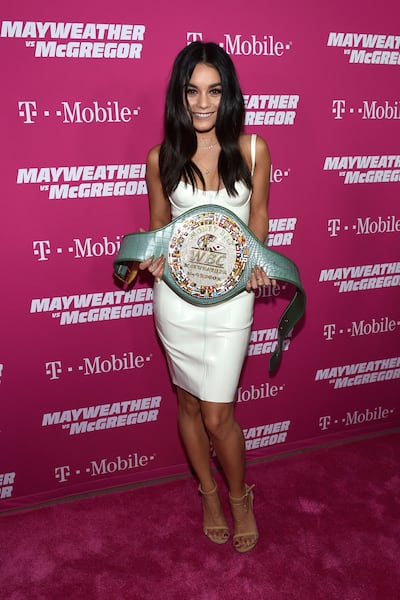
Then there were the rest of us, the world, with the combat-sport spectacle available for broadcast in more than 200 countries and territories. Millions of viewers eager to pay to see a pugilistic confection.
Willing suckers, all.
For months the two men had worked as hard in ginning up the match as training for it. During a four-city tour to promote the fight, they had engaged in foul-mouthed antics that reinforced how insufferable they might be in private company.
In this arena, at least, McGregor outdid his opponent, wearing a suit that spelled out an expletive in pinstripes, and telling Mayweather to "Dance for me, boy." Mayweather is black, while McGregor has the type of white Irish skin that the comedian George Carlin once called "phosphorescent."
But now it was time to bite down on a mouth guard and keep lips closed.
In one corner fidgeted McGregor. He grew up in the somewhat scrappy Crumlin section of Dublin and chucked a job as a plumber’s apprentice to focus on mixed martial arts. He has since become the sport’s most popular star, with assorted championships and controversies under his belt.
He is a working-class god to some in Ireland, a cringe-inducing embarrassment to others, especially given his habit of wrapping himself in the Irish flag as if it were a beach towel. He is quick-witted but crass, his lavish spending habits recalling for some the gross materialism that defined the rise and collapse of last decade’s Celtic Tiger economy.
According to the Irish writer Ewan McKenna, McGregor has forfeited his opportunity to wear the mantle of working-class hero, writing recently in the Irish Independent that the athlete from humble means “could have been so much more than just this hollow shell with money.”
In the other corner waited Mayweather, one of the most divisive sports figures of his day. Born in Grand Rapids, Michigan, he grew up poor in a family dogged by drugs and crime, but rose to become arguably the best pound-for-pound boxer of his generation. His athletic skills and business acumen — in real estate, clothing and marketing, among other ventures — have made him astoundingly wealthy, an achievement he underscores by posing for photographs with stacks of money, the way that others might pose with their children.
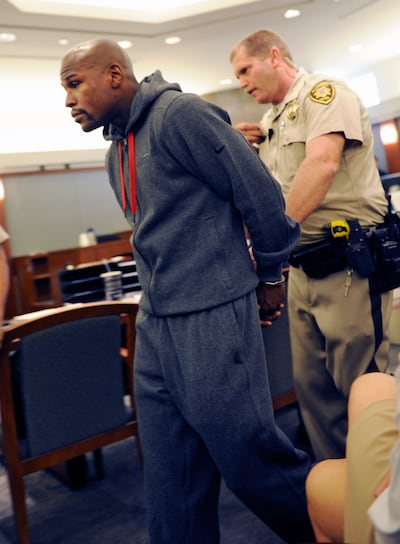
He has two separate criminal convictions related to domestic violence and served 60 days of a 90-day prison sentence in 2012. And there is this: After his fiancée broke up with him, alleging indiscretions, he posted images of a sonogram on Facebook to support his claim that he was the one who ended the relationship because, he said, she had aborted their twins. He also owns a strip club here; it is called Girl Collection.
Now the bell sounded, and the veteran and the rookie — fighting at the super-welterweight level of between 148 and 154 pounds — approached each other on a blue mat sporting the name of a beer company. They raised their gloved hands.
For months, pundits and scholars had debated the existential meaning of this event. Was it about the shifting fortunes in combat sports, with boxing in decline and mixed martial arts in undeniable ascent? Was it about race, an issue that boxing exploited at least as far back as the Jack Johnson-James Jeffries fight of 1910?
Or was it a reflection of — maybe even a distraction from — the times we live in, this Trumpian age when so much seems unsettled, if not unmoored? North Korea. Russia. Afghanistan. Sanctuary cities and border walls, the toppling of Confederate statues and the rise of white supremacists? In other words, race plus?
Perhaps bits of all these themes were at play. So, too, was the age-old attraction of violent combat between men, the bloodlust we pretty up with smiling ring girls and tuxedoed announcers. But in the end, all the hype, all the blather, all the posturing, all the media, was about only one achingly obvious thing: money.
As Paul Rouse, a professor at University College Dublin who specialises in sport, said: "It's a big ball of candy floss being confected by a small group of men who are making themselves extremely rich by packaging up something that people have always done and selling it through modern telecommunications."
Do some more math. With the fight’s purse, plus merchandise sales, plus pay-per-views at $100 apiece in the US, it is estimated that Mayweather — whose nickname is, in fact, “Money” — will earn more than $200 million. McGregor, it is thought, will earn a paltry $100 million. Fitting, then, that the event took place in Las Vegas; staging it anywhere else would have been an affront to the mercenary gods. The match belonged here — deserved quarantining here — along the Strip, where any authenticity is often just another act of illusion that leaves you double-checking your wallet’s whereabouts.
A walk to the venue from any approach reinforced this belief, but a logical path to take was one effectively controlled by MGM Resorts International, the hospitality and entertainment behemoth that was a partner in the Mayweather-McGregor circus.
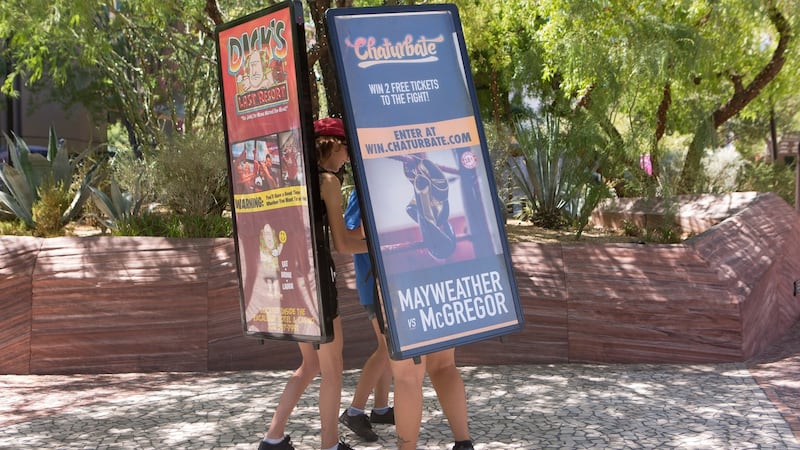
This walk began at the Mandalay Bay resort, which rises from the sun-baked Nevada flatness like a 43-story stack of gilded bricks. Here, as everywhere, the twinned half-visages of Mayweather and McGregor glowered from posters and video screens, an Orwellian pair of Big Brothers on watch for any flagging in the suspension of disbelief.
“Two Kings Collide,” the advertisements read, reinforcing the sense of an accident in the offing that had been floated earlier in the week by the Association of Ringside Physicians. The organisation had expressed fear that someone could get hurt, and that someone was McGregor.
Not far from one of these advertisements there was a memorabilia store in which another sportsman claiming royalty, the former baseball star Pete Rose, often sits. Banned from Major League Baseball for gambling and denied induction into the Hall of Fame, the so-called Hit King has a regular gig here as a window-display attraction.
The day before the fight, the squat legend was once again at his position, giving forced smiles for photographs and signing his name for money, each autograph like an author’s signature on a book telling the cautionary tale of a fallen king.
The mall led to the Luxor Las Vegas, a 30-story casino pyramid with an ancient Egyptian motif. Among its many attractions is one called “Bodies: The Exhibition,” an intriguing look at the miracle of the human form that leaves presumably unmentioned the damage done, say, from repeated blows to the head.
The Luxor then led to the Excalibur, a casino whose Medieval theme includes nightly jousting tournaments, which then led to New York-New York, a casino that does not, does not, evoke the city of its name. Up an escalator, through a parking garage, down another escalator and there, in the 105-degree sun, sat the T-Mobile Arena, where two supposed kings would supposedly collide.
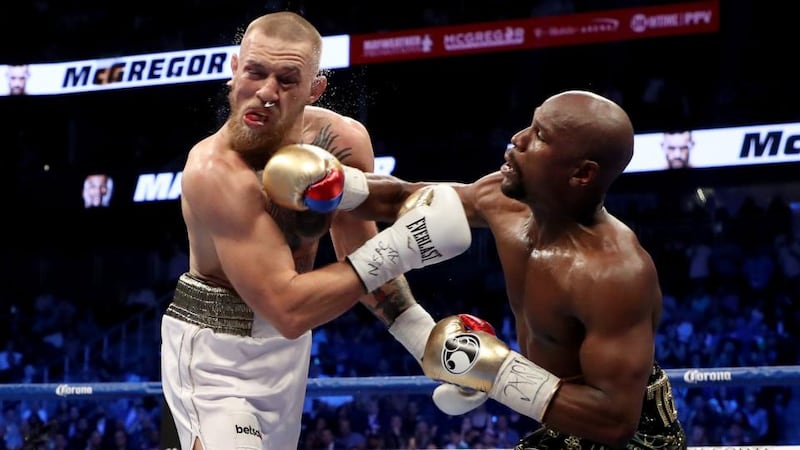
The stifling days preceding this night had been lightened by the thousands of McGregor fans who had come to support their man in states of infectious delusion. They frequently gathered in bouncing clutches to sing raucous songs, including a recent viral hit called “There’s Only One Conor McGregor” that repeats a few of the man’s crass boasts.
There’s only one Conor McGregor
And there’s no fighter better
And he’s going to knock out Floyd Mayweather
So Floyd watch out ’cause the Irish are coming
You can talk all you want, but you’ll do nothin’
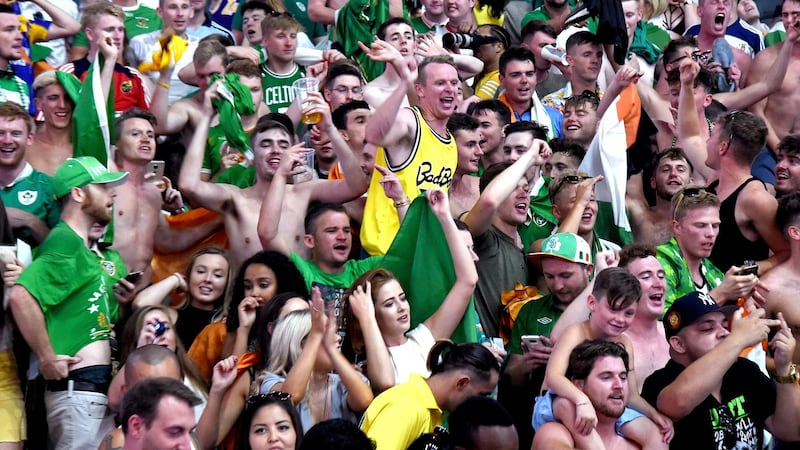
A Mayweather fan in a Mayweather T.B.E. T-shirt – for "The Best Ever" – watched one of these spontaneous bursts with an expression that was equal parts admiration and disbelief. His name was Kenny Smith, he was 35, and he owned both a pest control business in Las Vegas and a healthy understanding of the natural order of boxing.
Reflecting on this jubilant sea of whiteness before him, Smith, who is African-American, said he admired the tribalism of it. “I think it’s good and healthy, to be honest with you,” he said. “You should be proud of your culture.”
But, he added, the man representing his culture is going to demolish theirs. “For a mixed martial artist to try and box the greatest boxer on the planet Earth,” he said, his slow cadence emphasising the lack of any need to finish a statement of the obvious.
Now it was fight time.
In a city known for circuses and illusions, two men exchanged blows for less than 30 minutes. Nothing mattered; nothing was at stake.
And, when it was over, they hugged and laughed, a pair of business partners who had just pulled off the score of the century.
(New York Times service)









